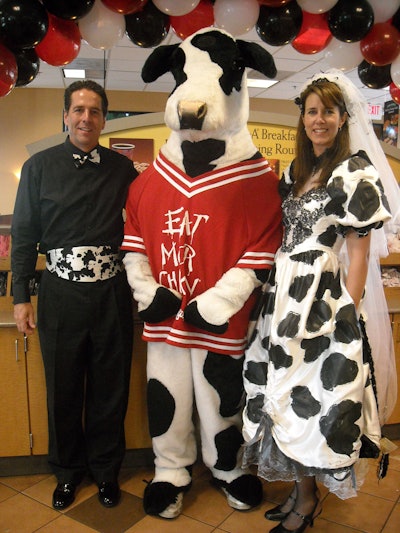
Advertising slogans and mascots often come and go while others endure.
One example of that endurance is Chick-fil-A’s “Eat Mor Chikin” campaign, featuring a black and white spotted cow.
Yeah, I get it. Cattle can’t spell, and they don’t want to be eaten.
And the quick service restaurant chain has done much with this campaign, with cartoon figures, mascots featuring people in cow suits, and promotions that go as far as encouraging customers to dress like cattle for Cow Appreciation Day.
But have you ever given any thought to the type of cattle featured in these advertisements? I’m not quite sure if Chick-fil-A has ever addressed it, but the color patterns of these mascot cattle are consistent with the patterns on Holstein cattle. And Holsteins are a breed primarily known as a dairy breed and not a beef breed.
I can understand to a degree why the company chose the Holstein look. It’s a better look than some major beef breeds like Angus, which are all black, or Charolais, which are all white. But why not a Hereford? They are multicolored and would stand out more, with their combination of a reddish-brown and white.
Perhaps it could be because when you use a Holstein, which doesn’t look as, well, beefy as other breeds, it actually makes eating a hamburger or steak less appealing.
Why it matters
Some of you might now be thinking: “Chill, Graber. It ain’t that big of a deal.”
But hear me out.
In portraying a dairy breed as a beef breed, Chick-fil-A is essentially promoting agricultural illiteracy.
I’m sure many in the poultry industry have seen a picture of backyard poultry or egg laying hens when used to portray a commercial broiler chicken operation. I can recall one example of how many publications in the mainstream media did so when covering the process that ultimately led to the merger of Wayne Farms and Sanderson Farms.
Now, even though the meat from layers can be and is eaten, just like the meat from dairy cattle can be and is eaten, that isn’t their primary purpose, and advertising campaigns such as these paint inaccurate pictures of agrifood production.
Large businesses like Chick-fil-A that depend on agriculture to keep them in operation should have an obligation to project more accurate images of agriculture, even if it is from a competing sector.
A compromise
I can understand if people think that the cattle are a cute part of Chick-fil-A’s image. But they don’t necessarily need to completely depart from that.
Why can’t the Holsteins make some friends. They can be cattle of the Herford, Gelbvieh or Texas Longhorn breeds. Make these cattle a bigger part of the campaign, and gradually phase out the Holsteins so it is less noticeable.
It may work. It may not. Regardless, it would certainly be nice to see Chick-fil-A making more of an effort to promote animal agriculture in a more accurate way.


















